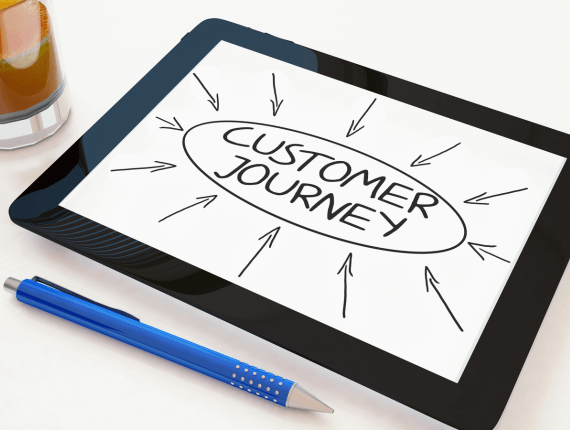Report “Customer Journey 2023: Searching and Buying Products Online”

In April of this year, Minds & Roses, in cooperation with Allegro, conducted a survey of online shopping paths among Polish consumers. 4,000 people were interviewed – each of whom had made an online purchase or planned to do so during the preceding three months of the survey. The purpose of the survey was, among other things, to gain knowledge about where to buy products or to determine the purchase drivers for a given shopping destination. Here are the key findings.
Digital customer journey
Marketplaces are the most popular destination from which consumers start their online search for products. These were indicated by 38% of respondents. In second place was Google (26%), in third place were online multibrand stores (9%), and in fourth place were price comparison sites (6%). Among marketplaces, the undisputed leader is Allegro – 88% of respondents start their shopping path (customer journey) there. This represents 34% of the total number of respondents.
The main purpose of visiting the aforementioned platforms is to check product prices. This is followed by “Getting an idea of the available product offerings.” In the first case, of the three most popular sites mentioned earlier, Allegro is by far the most popular, with 82% of indications. Google and online multibrand stores received 77% and 71% of indications, respectively.
And in the case of figuring out product offerings, multibrand stores received the most indications (59%). For this, Google decisively beats both major competitors when it comes to checking consumer reviews (49% against 35% and 34% for Allegro and multibrand stores, respectively).
And what is the order of the places on the podium when it comes to further steps on the purchase path? Here, Allegro wins as well. Almost half of the respondents (48%) also visited this marketplace for the next steps in their search for a product. For Google, the figure was 28%, while for multibrand stores it was 25%. It is worth mentioning that only 12% of the respondents declared that they did not do any search for information after the first shopping step.
During their customer journey (at any stage of it), 63% of respondents visit Allegro, 47% visit Google, and 31% visit multibrand stores. In the case of the former, nearly half of those surveyed said they have made a purchase there or intend to do so (followed by online multibrand stores with 21%). Allegro also boasts a very high percentage of people who declare that it is “my regular place to make purchases.”
Drivers of purchase, are the reasons for deciding to buy a product. The most frequently indicated purchase driver by respondents, and thus the strongest, is an attractive price. Fast delivery and ease of purchase ranked second and third, respectively.
Retailers should note that more than half of respondents (54%) want to move as quickly as possible from product search to purchase. 44% finalized the transaction the same day, and 17% bought the item they were looking for right away – almost two-thirds (64%) of respondents admitted that this was influenced by the attractive price. However, a similar percentage (60%) is able to delay the decision to buy a product in order to wait for an attractive promotion/discount.
Purchase habits
Respondents are most persuaded to buy a product at a new location by a more attractive price, no surprise here. It was indicated by 59% of percent of respondents. However, it is worth noting that as many as 84% are looking for a good product at an attractive price. Another motivator to use a new shopping destination is more attractive discounts and promotions (42%). Slightly behind them, by one percent, is a wide assortment and availability of products.
However, nearly a third of respondents (31%) are willing to pay more for a product from a well-known brand. 35% would settle for a non-branded substitute if its price was correspondingly lower. A similar percentage (34%) has no opinion on the subject. Interestingly, nearly twice as many respondents (44% vs 23%) prefer to buy products of well-known brands on marketplaces than in their online stores.
Point-of-purchase advertisement can be an important driver of sales. Nearly half of the respondents (49%) say they came across an attractive promotion thanks to advertising. Moreover, 35% admitted that advertisement convinced them to buy a brand they had never bought before. 30% of respondents declared that advertising made them shop faster. A similar percentage declare that advertisement encourages them to buy more often, and sometimes inspires them during the customer journey.
However, companies should not exaggerate with the amount of advertisements at the point of product purchase – for 50% of respondents there are too many of them. They also need to work on targeting – 3 in 10 respondents (31%) feel that the ads they see don’t apply to them.
Among all respondents, 36% are Smart Shoppers. These are consumers who carefully search for a good product at the best price. They also value their time – they care about buying the product they need as quickly as possible. They are tied to their favorite, tried-and-true stores, but they may be persuaded to a new shopping destination by the right drivers, such as attractive promotions or fast delivery (to a greater extent than other consumers).
Online shopping versus traditional shopping
It is crucial for companies to implement a consistent pricing strategy, with nearly two-thirds of respondents (64%) checking online the prices of products viewed in a traditional store.
Pet supplies are the category with the highest percentage of those declaring that it is better to buy online versus in brick and mortar (61% vs 9%). On the other end are groceries – in their case 49% say it is better to buy in traditional stores, with 25% indicating online shopping. It is worth noting that for 4 out of 10 respondents it does not matter whether the product is purchased online or in a stationary store.
Among the most important features of online shopping, respondents mentioned:
- the ability to read the opinions of other users,
- better product descriptions,
- more attractive prices,
- more opportunities to compare the product,
- more payment methods,
- better accessibility for the disabled,
- wider assortment and lower prices (even including delivery).
In contrast, for traditional stores, these features are as follows:
- better ability to adjust size (e.g., in the case of clothes),
- the ability to consult a salesperson while shopping,
- safety of shopping,
- freshness of products (e.g., in the case of groceries).

